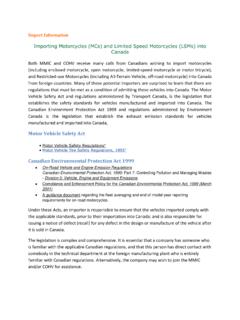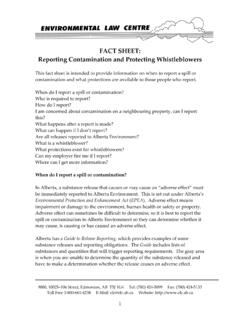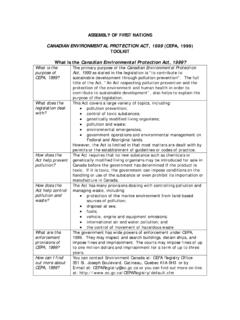Transcription of Canada Gazette – Order Amending Schedule 3 to the …
1 Vol. 145, No. 31 July 30, 2011 Order Amending Schedule 3 to the canadian EnvironmentalProtection Act, 1999 Statutory authorityCanadian environmental protection Act, 1999 Sponsoring departmentsDepartment of the Environment and Department of HealthREGULATORY IMPACTANALYSIS STATEMENT(This statement is not part of the Order .)Issue and objectivesCanada has committed to shared responsibility and cooperative efforts to address the international tradeof chemicals and pesticides. The Export Control List (ECL) in Schedule 3 to the canadian EnvironmentalProtection Act, 1999 (CEPA 1999 ) and the associated regulations help Canada to meet its internationalobligations. (see footnote 1) The ECL is a list of substances whose exports are controlled because theiruse in Canada is prohibited or restricted, or because Canada has accepted to control the export under theterms of an international agreement (for example, the Rotterdam Convention).
2 Section 100 of CEPA 1999provides the Ministers of the Environment and of Health with the authority to add or delete substancesfrom the ECL by Order . The ECL is subject to amendments that are published in the Canada proposed Order Amending Schedule 3 to the canadian environmental protection Act, 1999 (hereinafter referred to as the proposed Order ) proposes several additions and modifications to the proposed Order updates the ECL with new substances and groups of substances recently added toAnnex III of the Rotterdam Convention (see footnote 2) and also adds new substances to the ECL thathave recently been banned or restricted in Canada under domestic controls. Some of these substanceshave recently been added to the Stockholm Convention. (see footnote 3)These changes are important to meet Canada s continued compliance with its international obligationsunder the Rotterdam Convention and to support the implementation of the Stockholm Convention throughdomestic export control regulations.
3 Further modifications are proposed to provide greater clarity andreference for Canada is also proposing revisions to the existing regulations which control exports ofsubstances on the ECL to include provisions relating to the Stockholm Convention. This would ensure thatsubstances subject to the Stockholm Convention are appropriately controlled domestically. The revisions tothe regulations are being done Export Control ListSubstances listed to the ECL are grouped according to the following criteria:Part 1 includes substances whose use is prohibited in Canada . Under the authority of CEPA 1999 ,these substances can only be exported under very limited circumstances (such as for destruction).Part 2 includes substances for which notification or consent for export is required pursuant to aninternational agreement.
4 These substances are subject to the Prior Informed Consent (PIC)procedure of the Rotterdam Convention, which is an international convention promoting sharedresponsibility and cooperative efforts amongst Parties in the international trade of certain 3 includes substances whose use is restricted in Canada . Examples of these substances includeozone-depleting substances which may be exported subject to domestic export controls. Thesesubstances can be exported subject to the Minister being notified in regulations apply to exports of substances listed on the ECL: Canada Gazette Order Amending Schedule 3 to the canadian of 88/16/2011 9:01 AMThe Export Control List NotificationRegulations (ECLN Regulations) describe the manner in which tonotify the Minister of exports of all substances listed in the Export of Substances Under the Rotterdam Convention Regulations (ESURC Regulations) applyto exports of substances on the ECL, destined to another Party to the Rotterdam Convention.
5 Themain purpose of these Regulations is to ensure that substances on the ECL, subject to the PriorInformed Consent (PIC) procedure, are not exported to Parties to the Convention, unless theimporting Party has provided prior consent to the shipment. These Regulations require the exportersto have an export permit so that exports comply with the PIC procedure. Also under the RotterdamConvention, Canada is obligated to notify an importing Party when exporting a substance that issubject to a domestic ban or severe restriction for health or environmental reasons. In such cases,the Regulations are a means of collecting the necessary information through the application for anexport is concurrently underway for the development of a new instrument which merges andstreamlines the above regulations and introduces new provisions to allow Canada to deliver moreefficiently on export-related commitments made under the Stockholm Convention on PersistentOrganic Rotterdam ConventionAnnex III of the Rotterdam Convention, which entered into force in February 2004, establishes a list ofsubstances that have been banned or severely restricted by Rotterdam Parties for health and environmentalreasons.
6 The Convention facilitates information exchange between Parties in which the prior informedconsent of the importing Party is required prior to export. This Convention facilitates the process of export notification through which the exporting Party is obligated to notify and send information whenexporting a substance subject to domestic prohibition or restriction on Stockholm ConventionThe Stockholm Convention on Persistent Organic Pollutants (POPs) is a global treaty to protect humanhealth and the environment from highly dangerous, long-lasting chemicals by restricting and ultimatelyeliminating their production, use, trade, release and and rationaleThe proposed Order would make several additions and modifications to the Export Control proposed Order would add the following five substances to Part 1 of the ECL.
7 These substances areprohibited in Canada and are therefore proposed for inclusion in Part 1 of the ECL:Chlordecone (Chemical Abstracts Service [CAS] registry number (see footnote 4) 143-50-0);Endrin (1,2,3,4,10,10-hexachloro-6,7-epoxy-1,4, 4a,5,6,7,8, 8a-octahydro-exo-1,4-exo-5,8-dimethanona phthalene) [CAS 72-20-8];Toxaphene (CAS 8001-35-2);Alpha-HCH (CAS 319-84-6); andBeta-HCH (CAS 319-85-7).The current listings for endrin (Part 3, item 7), toxaphene (Part 2, item 25), and the HCH isomers (Part2, item 12) would be removed upon their addition to Part 1 of the ECL. All of these substances are listed inAnnex A of the Stockholm proposed Order would add the following three groups of substances, which have been added toAnnex III to the Rotterdam Convention, to Part 2 of the ECL:Dinitro-ortho-cresol (DNOC) and its salts (CAS 534-52-1; CAS 2980-64-5; CAS 5787-96-2; CAS2312-76-7);Dustable powder formulations containing a combination of benomyl at or above 7% (CAS17804-35-2), carbofuran at or above 10% (CAS 1563-66-2) and thiram at or above 15% (CAS137-26-8); andAll tributyltin compounds, includingTributyltin oxide (CAS 56-35-9); fluoride (CAS 1983-10-4); methacrylate (CAS 2155-70-6); benzoate (CAS 4342-36-3); Gazette Order Amending Schedule 3 to the canadian of 88/16/2011 9:01 AMTributyltin chloride (CAS 1461-22-9); linoleate (CAS 24124-25-2).
8 Naphthenate (CAS 85409-17-2). , a recent amendment to Annex III to the Rotterdam Convention added two substances that arecurrently in Part 3 of the ECL. These substances would be deleted from Part 3 of the ECL and added to Part2:Tetraethyl lead (CAS 78-00-2); andTetramethyl lead (CAS 75-74-1).The proposed Order would add nine substances or groups of substances to Part 3 of the ECL. Theseadditions are proposed because there are controls placed on these substances in Canada which restricttheir use:Benzidine and benzidine dihydrochloride, which have the molecular formulas C12H12N2 andC12H12N2 2 HCl, respectively (CAS 92-87-5; CAS 531-85-1);2-Methoxyethanol, which has the molecular formula C3H8O2 (CAS 109-86-4);Pentachlorobenzene, which has the molecular formula C6 HCl5 (CAS 608-93-5);Tetrachlorobenzenes, which have the molecular formula C6H2Cl4 (CAS 12408-10-5; CAS84713-12-2; CAS 634-90-2; CAS 634-66-2; CAS 95-94-3);Perfluorooctane sulfonate (PFOS) and its salts;Compounds that contain one of the following groups: C8F17SO2, C8F17SO3 or C8F17SO2N;Azinphos-methyl (CAS 86-50-0);Phorate (CAS 298-02-2); andTerbufos (CAS 13071-79-9).
9 Pentachlorobenzene is listed in Annex A of the Stockholm Convention. Perfluorooctane sulfonate, its saltsand perfluorooctane sulfonyl fluoride (contains the group C8F17SO2) are listed in Annex B of theStockholm from additions, the proposed Order would modify the ECL to ensure CAS registry numbers appearin the descriptions of all substances listed in all parts of the ECL (where applicable). CAS registry numbersare unique numerical identifiers and their inclusion within substance descriptions would provide exporterswith an additional means of identifying , the proposed Order would amend the descriptions of certain substances currently listed in Part 2of the ECL. The changes would harmonize the descriptions of these substances with those listed in AnnexIII of the Rotterdam Convention. Specifically, the proposed Order would do the following:Replace 2,4,5-T (CAS 93-76-5) (item 1) with 2,4,5-T and its salts and esters; Replace Dinoseb and dinoseb salts (CAS 88-85-7) (item 9) with Dinoseb and its salts andesters; Replace Pentachlorophenol (CAS 87-86-5) (item 17) with Pentachlorophenol and its salts andesters; Replace Monocrotophos (Soluble liquid formulations of the substance that exceed 600 g activeingredient / L) (CAS 692322-4) (item 18) with Monocrotophos (CAS 6923-22-4).
10 Replace Methyl-parathion (emulsifiable concentrates (EC) with , 40%, 50%, 60% activeingredient and dusts containing , 2% and 3% active ingredient) (CAS 29800-0) (item 20) with Emulsifiable concentrates containing methyl parathion at or above and dusts containingmethyl parathion at or above (CAS 298-00-0); and Replace Parathion (all formulations aerosols, dustable powder (DP), emulsifiable concentrate(EC), granules (GR) and wettable powders (WP) of this substance are included, except capsulesuspensions (CS)) (CAS 56-38-2) (item 21) with Parathion (CAS 56-38-2). Benefits and costsThe economic impact of the proposed Order is estimated to be low. The impacts are difficult to quantifybut likely small in magnitude. They are discussed qualitatively on the ECL are subject to the provisions of the ECLN Regulations and the ESURCR egulations.












